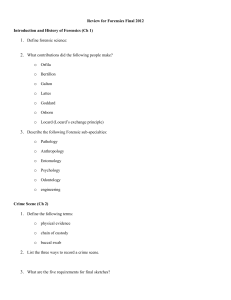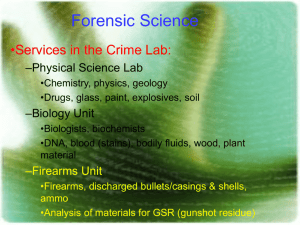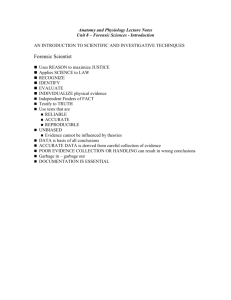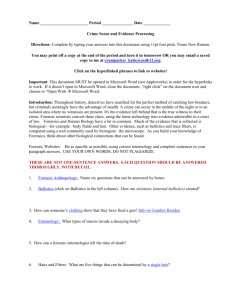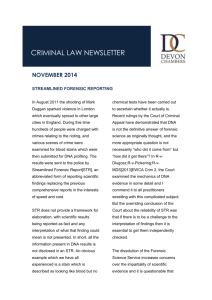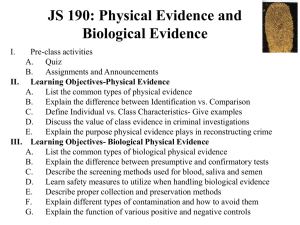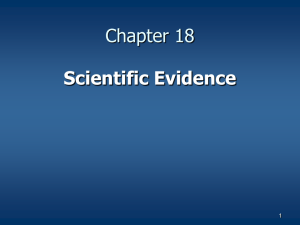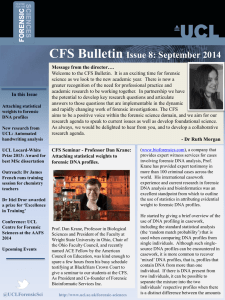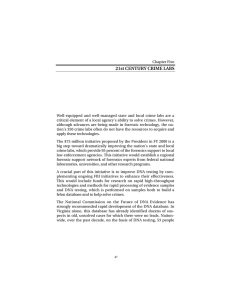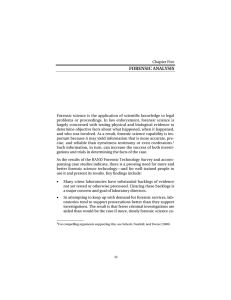Welcome to Forensic Science
advertisement
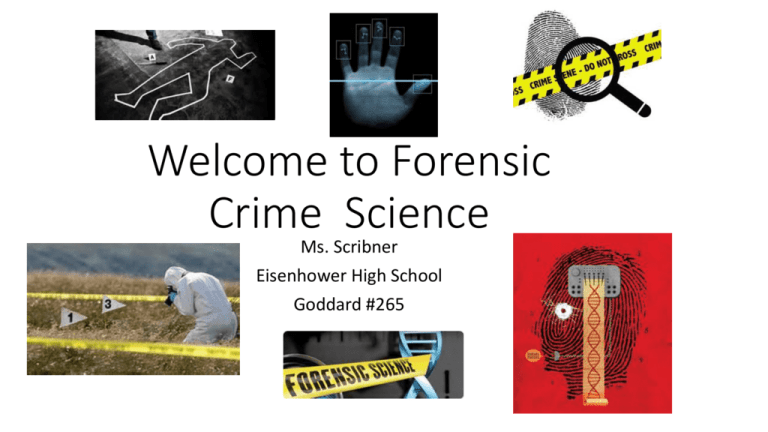
Welcome to Forensic Crime Science Ms. Scribner Eisenhower High School Goddard #265 Qualified Admission Course – articulated agreement with WATC for college credit Science credit for high school graduation AND Science credit to enter college Law, Public Safety & Security CTE • Application Class—Forensic Science Comprehensive #44225 (1 credit) Video • https://animoto.com/play/0bzvOx41xtEHPKanaD2SfQ Science Forensic science is any scientific field that is applied to the field of law • Scientific Method • Application of scientific concepts • Lab Reports • Data Collection • Analysis of Data • Documentation • Drawing Conclusions • Formal letters communicating results Mathematics • Geometry –position and space • Trigonometry-angle • Angle of Impact • Time of Death • Rf Value Common Core • The Common Core asks students to read stories and literature, as well as more complex texts that provide facts and background knowledge in areas such as science and social studies. • Students will be challenged and asked questions that push them to refer back to what they’ve read. • This stresses critical-thinking, problem-solving, and analytical skills that are required for success in college, career, and life. College and Career Ready • Students are “employees” of the ABC Forensic Science Company. They can “try on” the career of a lab technician, field investigator, or law enforcement. Engaging Students Compentencies Introduction • Discuss careers available in the field of forensic science and training required for each • Distinguish individual evidence from class evidence and discuss its relevance in a court of law • Justify use of observation skills and debate validity of eyewitness accounts of events • Practice HazMat and Bloodborne Pathogen safety Crime Scene Investigation • Differentiate procedures for securing & documenting a crime scene • Perform evidence collection and storage Trace Evidence • Develop, analyze and classify fingerprints • Identify & compare various types of shoe, tire, palm, lip, and bite prints • Analyze, identify, and compare various hair samples • Compare various types of fibers through physical and chemical analysis Drugs & Toxicology • Perform tests to identify various drugs and/or poisons • Research and examine how various drugs &/or poisons affect and/or move through the human body Soil & Glass Analysis • Deduce, compare & contrast characteristics of various types of sand and soil • Use refractive index and density to determine differences in small particles of glass Serology • Distinguish between human and animal blood • Accurately type blood • Explore bloodstain patterns as a function of velocity, direction and height of fall DNA Analysis • Describe crime scene evidence collection and processing to obtain DNA • Isolate and extract DNA from cells • Justify use of DNA to determine family connections • Examine use of DNA in the legal process Forensic Entomology • Outline the succession of various types of insects found on a body as it decomposes • Deduce time of death using insect evidence Human Remains • Use a human skeleton to determine gender, age range, height and race • Predict time of death using rigor mortis, algor mortis, livor mortis, and stages of decomposition • Distinguish between cause, manner, and mechanisms of death 10 Handwriting/Document Analysis • Characterize facets of individual handwriting • Distinguish between different handwriting styles • Conduct an experiment using paper chromatography to determine the ink used • Describe features of paper currency used to detect counterfeit bills 11. Ballistics & Tool Marks • Distinguish between types of firearms and ammunition • Use bullet trajectory to determine position of shooter • Design and conduct scientific investigations to match tool marks in a criminal investigation • Distinguish between impressions with microscopic examinations Equipment Needed for Success: Pen or Pencil (everyday) 3-Ring Binder (at least 1½ inches 1 Glue Stick Scissors 1 Roll of Clear Tape OR 1 Roll of Masking Tape non-latex gloves DAILY ROUTINE • Copy Daily assignment in notebook. • JOB PREP----BELLWORK assignment. (3-5 min.) • STAFF BRIEFING--- overview of day's lesson/work. (2-3 min.) • TASK---Lesson/work, lecture notes, AV notes, lab, etc.(approx 45 min.) • Clean up/storage. Review of assignments given. (5 min.) Hands-On application of scientific concepts Electrophoresis Documentation—writing for comphrension Questions? • Email: dscribner@goddardusd.com • Class website can be found at: http://ehs.goddardusd.com/scribner Facebook page: search Eisenhower High School Forensic Science Class—LIKE and FOLLOW


